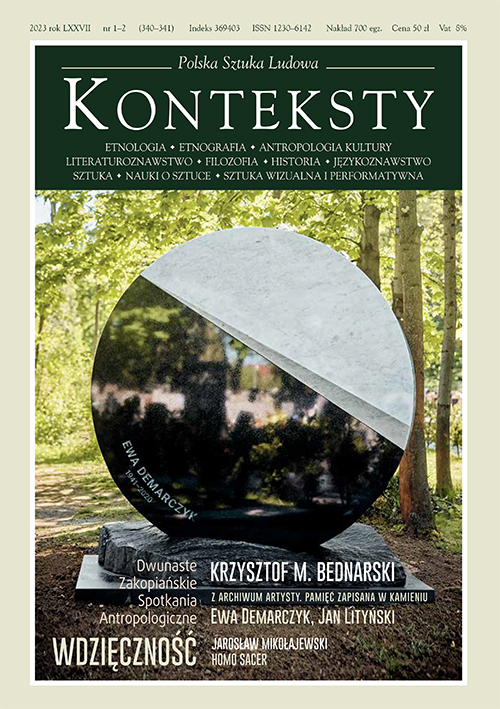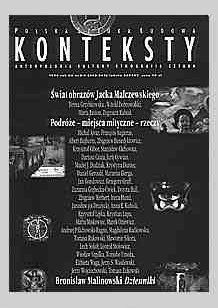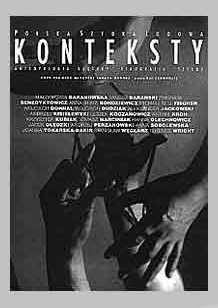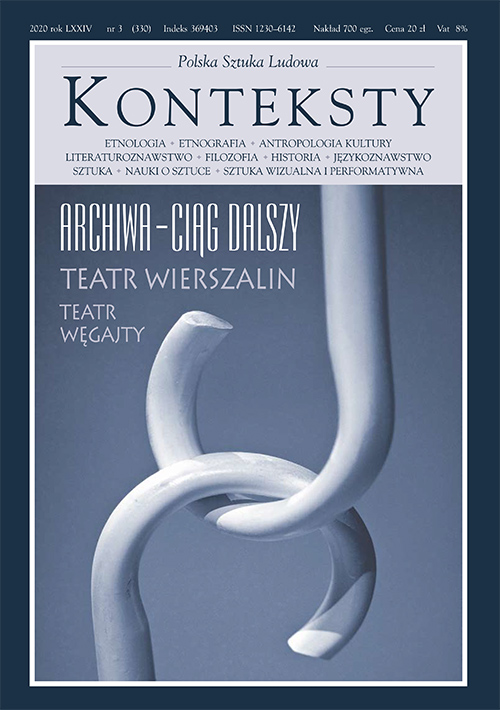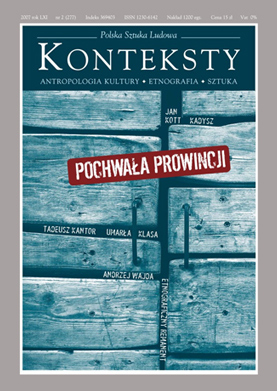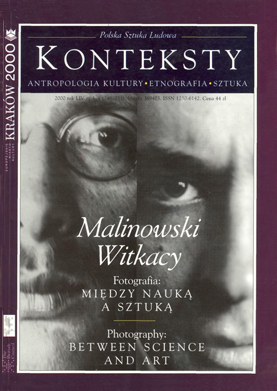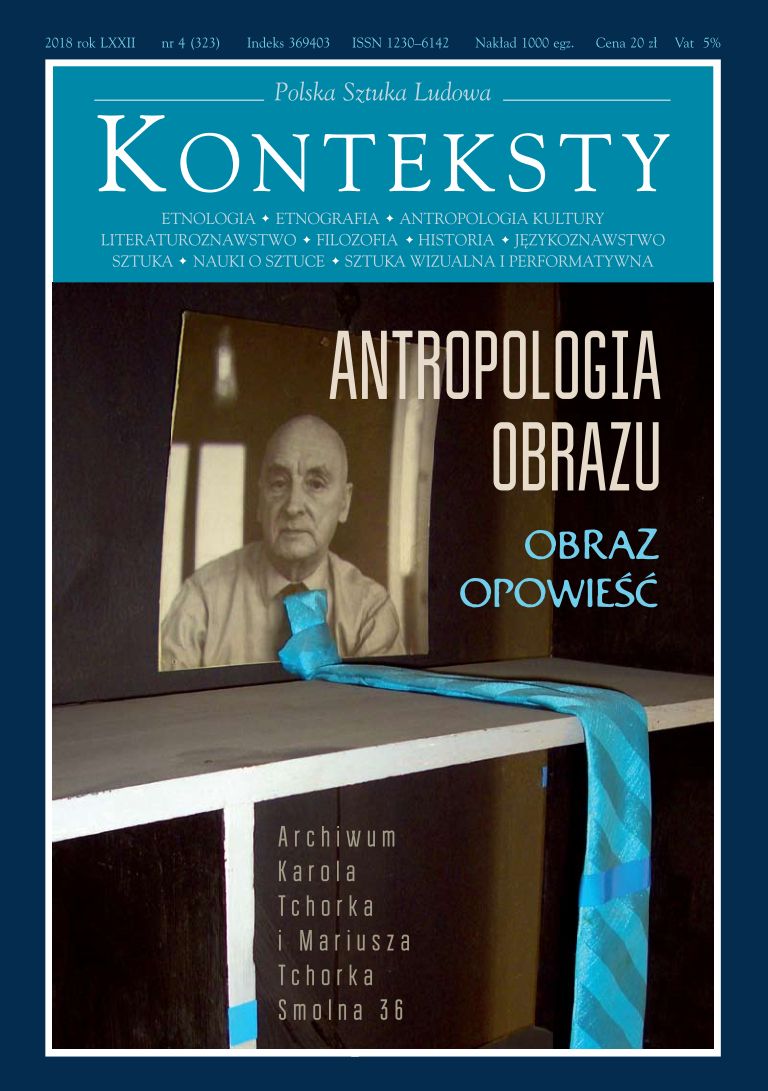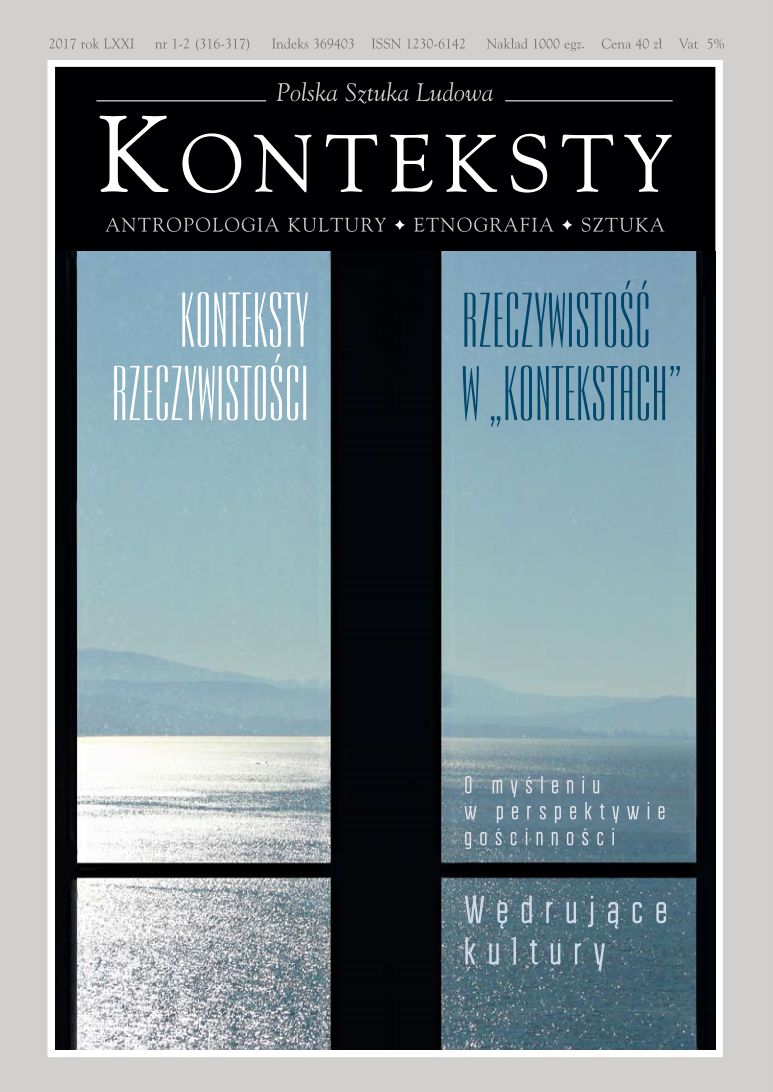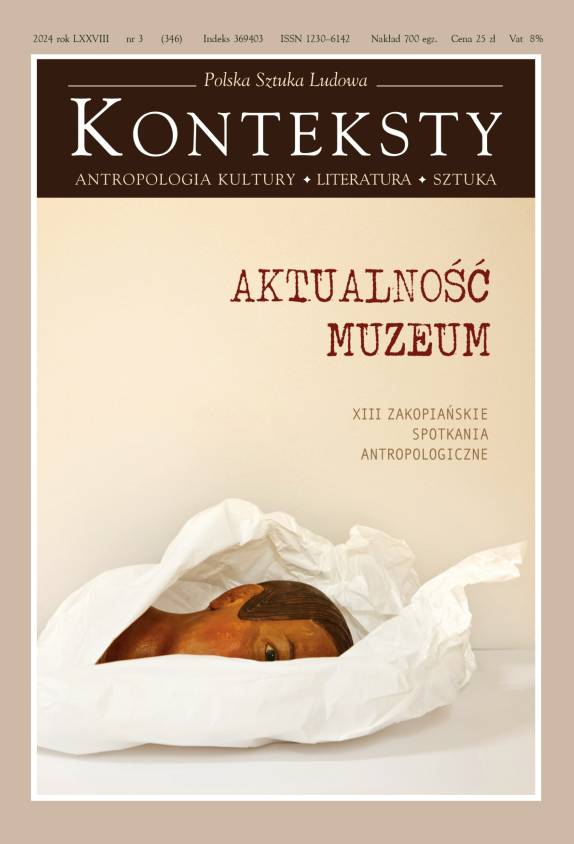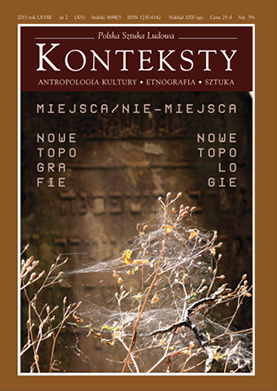Issue 2016/2 (313) - All Corners of the World will Come Together

| *** | ||
| Zbigniew Benedyktowicz | Spaces of Encounter | 3 |
| Zbigniew Benedyktowicz, Małgorzata Sady | All Corners of the World will Come Together – Conversation about the Fourth Edition of the 2014 Ars Polonia Biennale in Opole | 4 |
| Małgorzata Sady | All Corners of the World will Come Together | 8 |
| N. N. | Biennale Ars Polonia - Program | 9 |
| N. N. | Barbara Drążkowska, Marcin Lenarczyk, Szymon Brzóska, Mischa Giancovich – biographical notes | 10 |
| Ewa Benesz | Biography | 12 |
| Janusz Bogucki | Ewa’s Theatre | 16 |
| Ewa Benesz | I Don’t Love Mickiewicz  | 20 |
A series of texts presenting the artistic undertakings of Ewa Benesz, an actress associated with, i.a. the Puławy Theatre Studio and the Laboratory Theatre. Extracts from journals and accounts by her co-workers pertain to, among others, the period when Benesz co-created the Puławy Theatre Studio and travelled across Eastern Poland reciting the text of Master Thaddeus; they also depict her subsequent para-theatrical activity in Italy. | ||
| Ewa Benesz | Notes about Zbigniew Herbert  | 40 |
A series of texts presenting the artistic undertakings of Ewa Benesz, an actress associated with, i.a. the Puławy Theatre Studio and the Laboratory Theatre. Extracts from journals and accounts by her co-workers pertain to, among others, the period when Benesz co-created the Puławy Theatre Studio and travelled across Eastern Poland reciting the text of Master Thaddeus; they also depict her subsequent para-theatrical activity in Italy. | ||
| Przemysław Łoś | “Master Thaddeus” by Adam Mickiewicz and Ewa Benesz – a Note about the Need for Contemplation | 44 |
| Ewa Benesz | Nell’atto del creare | 48 |
| Ewa Benesz | Kore e Demetra | 52 |
| Ewa Benesz | Letter to Orpheus | 55 |
| Ewa Benesz | Memory | 56 |
| Zbigniew Benedyktowicz | Between Warsaw and East Village | 58 |
| Małgorzata Baranowska | The Internal Window of a City  | 62 |
The article has been published in catalogue for the exhibition Miłosz Benedyktowicz 1945-1992. The Gallery and the Museum of the Academy of Fine Arts In Warsaw, December 1994-January 1995. | ||
| Joanna Helander | Biogram | 66 |
| Joanna Helander | Emmigration  | 68 |
A series of texts about the artistic ventures of Joanna Helander, photographer, director, and author born in a Jewish German-speaking family from Silesia and since 1971 living as an émigré in Sweden. The presented texts refer to the artist’s difficult and complicated family history ever intermingled with the history of Nazism and communism. | ||
| Joanna Helander | Returning to Luboszyce  | 70 |
A series of texts about the artistic ventures of Joanna Helander, photographer, director, and author born in a Jewish German-speaking family from Silesia and since 1971 living as an émigré in Sweden. The presented texts refer to the artist’s difficult and complicated family history ever intermingled with the history of Nazism and communism. | ||
| Joanna Helander | Postcard for Leopold  | 77 |
A series of texts about the artistic ventures of Joanna Helander, photographer, director, and author born in a Jewish German-speaking family from Silesia and since 1971 living as an émigré in Sweden. The presented texts refer to the artist’s difficult and complicated family history ever intermingled with the history of Nazism and communism. | ||
| Joanna Helander | Quotes from the film Returns | 79 |
| Bo Persson | Biogram | 81 |
| Joanna Helander, Bo Persson | Watching the Moon at Night | 83 |
| Inga Fonar Cocos | Biogram | 84 |
| Inga Fonar Cocos | Name  | 87 |
Block of texts about Inga Fonar Cocos, an Israeli artist born in Poland and a resident of Tel Aviv, author of predominantly video works such as “Name” described in this text. | ||
| Inga Fonar Cocos | Two Homelands  | 88 |
Block of texts about Inga Fonar Cocos, an Israeli artist born in Poland and a resident of Tel Aviv, author of predominantly video works such as “Name” described in this text. | ||
| Renata Buziak | Biogram | 90 |
| Renata Buziak | Exhibition in Opole  | 91 |
Block of texts about Renata Buziak, Polish artist working and living in Australia. | ||
| Renata Buziak | My Roots are There  | 93 |
Block of texts about Renata Buziak, Polish artist working and living in Australia. | ||
| Victoria Garnons-Williams | Renata Buziak: Floribundum in extremis  | 96 |
Text about photographic work of Renata Buziak in the context of history of photography. | ||
| Andriej Chrzanowski | Biogram | 100 |
| Andriej Chrzanowski | About Josif Brodski  | 102 |
Block of texts about Andriej Chrzanowski, film director, scriptwriter, author of animated movies, working and living in Moscow. | ||
| Andriej Chrzanowski | About the film One and a Half Room  | 106 |
Block of texts about Andriej Chrzanowski, film director, scriptwriter, author of animated movies, working and living in Moscow. | ||
| Camilla Panufnik | Biogram | 110 |
| Camilla Panufnik | Polish Pines  | 111 |
Family members recollect Andrzej Panufnik – Polish composer and director who in 1954 emigrated to England. The authorities of People’s Poland issued a censorship ban on the performance and publication of his compositions, not revoked until 1977. | ||
| Andrzej Panufnik | Biogram | 112 |
| Roxanna Panufnik | Biogram | 113 |
| Andrzej Klimowski | Biogram, quotes | 114 |
| Piotr Dąbrowski | Posters by Andrzej Klimowski | 118 |
| Marcin Giżycki | Andrzej Klimowski, Poet of Reality and Dreams  | 122 |
Marcin Giżycki presented the life and works of the titular painter, graphic artist, and author of graphic stories, posters, book illustrations and animated films, and a descendant of Polish émigrés living in England. | ||
| Krystyna Piotrowska | Biogram | 124 |
| Krystyna Piotrowska | Good Times  | 126 |
A series of texts discussing the artistic undertakings of Krystyna Piotrowska – a representative of the visual and graphic arts, author of films and video installations, and curator – pertaining to the problem of memory, Jewish identity, consequences of the events of March 1968, and the story of her emigration to Sweden. | ||
| Katarzyna Bojarska | Art of the Sites of Oblivion  | 128 |
A text accompanying and summing up successive editions of the Próżna Project. “By organising in 2005-2010 exhibitions of most recent Polish and foreign art displayed in town houses, entrances, courtyards, and their relics in Próżna Street, Krystyna Piotrowska staged meetings with history that proved to be equally non-obvious and painful. Through the intermediary of imagination and artistic undertakings this project brought to life not so much an absent world of the past (absent materially but present in the conceptual reality of the town and some of its residents) as the fact that this world has been annihilated and that in a short while it remnants will vanish together with a chance that someone might stumble across them and laboriously extract the art of memory by resorting to art”. | ||
| Krystyna Piotrowska | I Left Poland Because...  | 132 |
A series of texts discussing the artistic undertakings of Krystyna Piotrowska – a representative of the visual and graphic arts, author of films and video installations, and curator – pertaining to the problem of memory, Jewish identity, consequences of the events of March 1968, and the story of her emigration to Sweden. | ||
| Krystyna Piotrowska | Her Hair  | 136 |
A series of texts discussing the artistic undertakings of Krystyna Piotrowska – a representative of the visual and graphic arts, author of films and video installations, and curator – pertaining to the problem of memory, Jewish identity, consequences of the events of March 1968, and the story of her emigration to Sweden. | ||
| Tomasz Pobóg-Malinowski | Biogram | 138 |
| Tomasz Pobóg-Malinowski | Means of Artistic Expression of Western Sub-culture within the Context of Trends and Tendencies in Art of the 1960s  | 141 |
Fragments of a diploma dissertation presented by the author at the Łódź Film School in 1974. A description of counterculture currents developing in the 1960s, such as the beatnik and hippie subculture, as well as their connections with the domain of art, i.a. pop art, graffiti, and the alternative theatre. | ||
| Tomasz Pobóg-Malinowski | Dictionary of Terms from the “Beat Generation” Slang Subsequently Used by Young Hippies and Students during the 1960s  | 161 |
Fragments of a diploma dissertation presented by the author at the Łódź Film School in 1974. A description of counterculture currents developing in the 1960s, such as the beatnik and hippie subculture, as well as their connections with the domain of art, i.a. pop art, graffiti, and the alternative theatre. | ||
| Joanna Rajkowska | Biogram | 164 |
| Joanna Rajkowska | Chariot  | 170 |
Portrayal of the artist and a description of her most important works, i.a. the Chariot project realised in London in 2010. | ||
| Eugeniusz Rudnik | I Am So Proud That I Begin to Whisper Quietly – I’m Important…  | 173 |
Reminiscences by an outstanding Polish composer, electronics engineer, and sound director (d. October 2016) about the beginnings of electronic music in Poland (at the acclaimed Polish Radio Experimental Studio). | ||
| Eugeniusz Rudnik | Explication – “We” | 178 |
| Eugeniusz Rudnik | A selection of texts by Eugeniusz Rudnik and about him | 180 |
| Barbara Goshu | Under the Umbrella of Love | 186 |
| Stanisław Chojnacki | Paintings by Barbara and Worku Goshu  | 188 |
Fascination with the Ethiopian tradition of the icon inspired Barbara Goshu to paint on stone and wooden board. S. Chojnacki presented the artistic undertakings of Barbara and Worku Goshu and their striving towards attaining equilibrium between modern means of expression and the traditional atavistic manner used by the painters of ancient Ethiopia. | ||
| Izabela Plucińska | Biogram | 190 |
| Izabela Plucińska | I Observed the New Me…  | 192 |
Block of texts about Izabela Plucińska, a Polish artist living in Berlin and author of, i.a. the oft-rewarded animated film Jam Session. | ||
| Izabela Plucińska, Kuba Grabski | “I Can Do Anything That I Devise”  | 194 |
Block of texts about Izabela Plucińska, a Polish artist living in Berlin and author of, i.a. the oft-rewarded animated film Jam Session. | ||
| Piotr Matywiecki | Photography  | 197 |
An essay by Piotr Matywiecki, poet and essayist, about the literary context of photography: “One of the most influential contemporary myths is that of photography. To a certain degree the present-day world has adapted itself to the photograph and became ‘photogenic’. By the very nature of things this myth performs its greatest role in all that is visual and in the domain of the visual arts. Nonetheless, in a manner befitting a myth, it has already long ago expanded onto other spheres. In my essay I shall deal with the photographic qualities of speech, or, more narrowly, of literature and even more precisely: the works of Franz Kafka. The characteristic feature of this oeuvre, however, means that it immediately universalises each aspect of the reality, which it absorbs because it looks at it from a distance. In other words, while writing about the photographic qualities of Kafka’s prose I shall, by the force of things, write simply about literature as such and human speech. Quite possibly, it is precisely language that guides photography out of the darkroom of the myth and into the light of rationality. I cannot look at a photograph and think about it without activating assorted literary references in my consciousness“. | ||
| Adam Mazur | Self-portrait of Europeans  | 217 |
The author brings the reader closer to the conception and theme of two exhibitions of the photographic portrait on show in 2015 and 2016 in European centres: FACES European Portrait Photography since 1990 and Mit anderen Augen. Das Porträt in der zeitgenössischen Fotografie. While referring to assorted ways of representing Eastern Europe and Poland the author pondered the reasons for the frailty of Polish portrait photography. An outline of the historical context of Polish post-1989 portrait photography is preceded by an analysis of works by Krzysztof Gierałtowski, the only Polish photographer to uninterruptedly pursue the portrait since the 1960s. The text ends with an analysis of ‘Portrety bez twarzy’, a book by Gierałtowski, which constitutes both his manifesto and a settlement of accounts, with the artist regarding himself as a great failure at the time of political, social, and technological changes. | ||
| Zbigniew Benedyktowicz, Krzysztof Gierałtowski | Why a Portrait Without a Face? – Recorded Conversation  | 225 |
A conversation concerning Portrait Without a Face – an exhibition and album by Krzysztof Gierałtowski presenting a series of photographs of eminent representatives of Polish culture and politics. While recounting the circumstances of the origin of particular photographs their author disclosed workshop arcana and portrayed the characteristic style of his creative photography. | ||
| Antoni Kroh, Barbara Magierowa | Poles and Poland Fragments of “Prywatny Leksykon Współczesnej Polszczyzny”  | 243 |
Fragment of the monumental „Prywatny Leksykon Współczesnej Polszczyzny” encompassing expressions, sayings, and metaphors that appeared (and often had already vanished) in the vernacular and the press after 1945. | ||
| Antoni Kroh, Barbara Magierowa | The Palace of Culture and Its Surrounding in the Polish Language  | 259 |
Fragment of the monumental „Prywatny Leksykon Współczesnej Polszczyzny” encompassing expressions, sayings, and metaphors that appeared (and often had already vanished) in the vernacular and the press after 1945. | ||
| Łucja Iwanczewska, Ewelina Godlewska-Byliniak, Marta Kufel | Kantor. Theorem of Salvation  | 261 |
An account of a meeting discussing Marta Kufel’s book: „Błędne Betlejem Tadeusza Kantora” (2013), which took place in the Theatre Institute in Warsaw. | ||
| Paweł Próchniak | Places of Non-existence Extracts  | 271 |
The essay deals with relations between topography and literature co-creating the “syntax” and the “lexis” of meanings variously connected with Shoah. The analytical material consists of texts by outstanding poets and prose writers: Tadeusz Różewicz, Leopold Staff, Krzysztof Kamil Baczyński, Mieczysław Jastrun, Jerzy Ficowski, Leo Lipski, and Ludwik Hering, as well as anonymous notes and oral testimony attempting to tackle an “incomprehensible and inexpressible reality”, while the titular “places of non-existence” affected by the Holocaust are empty husks of ”real presence” albeit, at the same time, they store – in the manner of negatives – actual existence subjected to extermination and annihilated. | ||
| Jacek Gernat | The Nautical and Pomeranian Monuments of Władysław Hasior  | 279 |
After 1945 the cultural landscape of Pomerania was enhanced by numerous monuments, which comprised an essential propaganda element of shaping a new, Polish identity for this territory, a task pursued by the communist authorities. This objective was served by the monuments’ iconography connected with the sea and pertaining to Pomerania and its links with the Fatherland, restored as a result of armed combat. Such symbolic is associated with monuments by Władysław Hasior (1928-1999), author of three novel conceptions of statues intended for this region. The solutions proposed by Hasior make use of motifs close to the propaganda iconography of other Pomeranian monuments dating from the time of People’s Poland; simultaneously, their high artistic standard and original features make it possible to hazard the opinion that the sculptor conceived the lofty historical theme as a pretext enabling him to realise his pioneering notions, a feat accomplished by Ptaki (Birds) in Koszalin. | ||
| Krystyna Czerni | Homework Assignment: A Composition  | 291 |
An essay on the works of Bettina Bereś, locating them within the perspective of a discussion about experiencing daily life and the “female experience” as well as within the context of the concept of “bustling about” described by Jolanta Brach-Czaina. Another counterpoint to Bettina Bereś’ oeuvre is her mother, Maria Pinińska-Bereś. | ||
| Janusz Lachowski | New Research Perspectives on Franciszka and Stefan Themerson’s oeuvre. The Case of Film Output  | 299 |
Franciszka and Stefan Themerson’s achievements are becoming increasingly popular among Polish researchers. Although the artistic work of ‘Drobiazg melodyjny’ authors inspired the appearance of an extensive academic literature, also for the general public, it seems that the Themersons remain artists who are not studied in depth and that many research topics connected with them have not yet been discovered. What lies behind this situation is not only versatility of their interests and an extensive output, but also a distant location of the archive they left, whose major part remained in Great Britain until the end of 2014. The article concerns new research perspectives, especially those connected with film output, which arose when almost whole Themersons’ legacy was brought to Poland. Undoubtedly the presence of the archive in our native country will enable the analysis of so far either unknown or no well researched areas of life and activity of the extraordinary tandem. | ||





